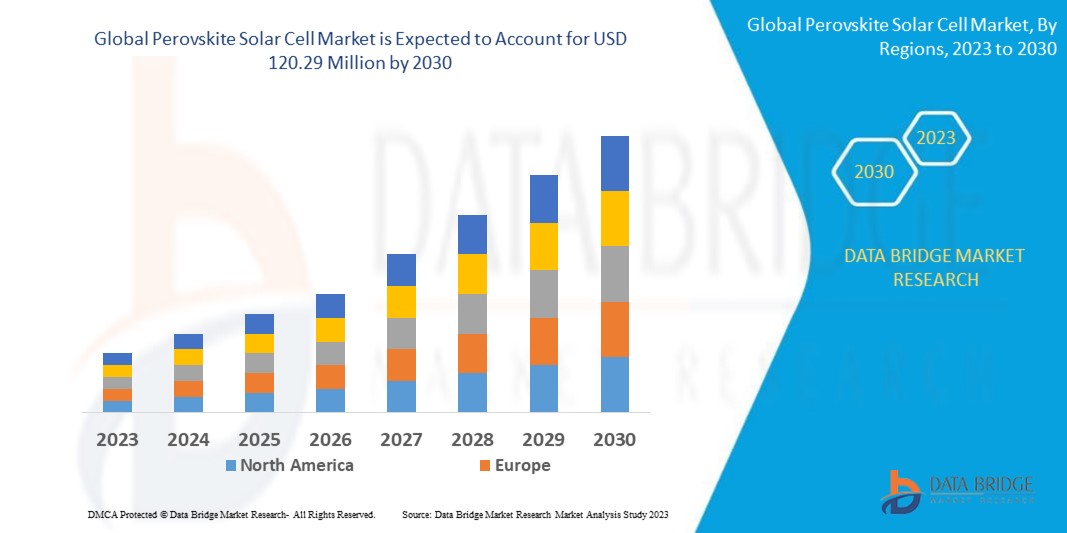Perovskite Solar Cell Market: Paving the Way for the Next Generation of Solar Energy
Global Perovskite Solar Cell Market Size, Share, and Trends Analysis Report – Industry Overview and Forecast to 2032
https://www.databridgemarketresearch.com/reports/global-perovskite-solar-cell-market
The global perovskite solar cell market size was valued at USD 193.85 million in 2024 and is projected to reach USD 7011.63 million by 2032, with a CAGR of 56.60% during the forecast period of 2025 to 2032

The Perovskite Solar Cell (PSC) Market is rapidly emerging as one of the most promising segments in the renewable energy industry. Known for their remarkable efficiency, flexibility, and cost-effectiveness, perovskite solar cells are transforming the global solar landscape. With increasing emphasis on sustainable energy solutions and technological innovation, the perovskite solar cell market is projected to witness significant growth in the coming years.
Introduction to Perovskite Solar Cells
Perovskite solar cells are a new class of photovoltaic technology based on materials with a crystal structure similar to the mineral perovskite (calcium titanium oxide). These materials exhibit excellent light absorption, charge carrier mobility, and easy fabrication properties, making them ideal for solar energy applications. Unlike traditional silicon-based solar cells, perovskite cells can be produced using simpler, low-temperature processes, reducing overall manufacturing costs.
Since their discovery in 2009, perovskite solar cells have evolved from an initial efficiency of about 3% to over 25% in laboratory conditions, matching or even surpassing conventional silicon technologies. Their potential to be integrated into flexible, lightweight, and semi-transparent forms offers vast opportunities across residential, commercial, and industrial sectors.
Market Drivers
1. Rising Demand for Renewable Energy
The global push toward clean and renewable energy sources has been a key factor driving the growth of the perovskite solar cell market. Governments worldwide are implementing stringent carbon emission regulations and investing heavily in sustainable energy infrastructure. As perovskite technology promises higher efficiency and lower costs, it is becoming an attractive alternative to traditional photovoltaic systems.
2. Cost Efficiency and Easy Manufacturing
One of the biggest advantages of perovskite solar cells is their low-cost manufacturing process. Unlike silicon solar cells, which require expensive materials and high-temperature processing, perovskite cells can be produced using solution-based methods, such as printing and coating. This simplicity reduces energy consumption during production and enables mass manufacturing at lower costs.
3. Rapid Technological Advancements
Continuous research and development activities have led to notable improvements in the stability and efficiency of perovskite solar cells. Innovations such as tandem structures—combining perovskite with silicon—have pushed conversion efficiencies beyond 30%, creating strong competition with established technologies. These advancements are accelerating commercial adoption and opening new opportunities in the solar energy sector.
4. Growing Investment and Partnerships
The market is witnessing increased investments from both private companies and public institutions. Several leading solar companies, research universities, and technology startups are collaborating to develop scalable manufacturing techniques and improve the durability of perovskite cells. This surge in strategic partnerships is expected to expedite commercialization and market penetration.
Market Challenges
Despite the rapid progress, certain challenges continue to restrain market growth. The primary concern is stability and durability. Perovskite materials are highly sensitive to moisture, heat, and ultraviolet light, which can degrade their performance over time. Research efforts are ongoing to enhance encapsulation and material stability to make these cells more reliable for long-term use.
Another challenge lies in scalability. While perovskite solar cells have demonstrated impressive results in laboratory settings, scaling up to commercial production remains a technical hurdle. Uniform film deposition and defect control on large substrates are areas that require further innovation.
Additionally, the environmental impact of lead-based perovskite materials has raised concerns. Many research institutions are exploring lead-free alternatives that maintain high performance while being environmentally safe.
Market Segmentation
The perovskite solar cell market can be segmented by type, application, and region.
By Type:
Hybrid Perovskite Solar Cells: Combine organic and inorganic materials to balance efficiency and stability.
Flexible Perovskite Solar Cells: Lightweight and adaptable for wearable and portable devices.
Tandem Perovskite Solar Cells: Stack perovskite with other materials like silicon to achieve higher efficiency.
By Application:
Residential: Rooftop solar installations and integrated energy systems.
Commercial and Industrial: Large-scale solar farms and building-integrated photovoltaics (BIPV).
Consumer Electronics: Power sources for IoT devices, sensors, and portable gadgets.
Automotive: Integration into electric vehicles and solar-powered transport systems.
By Region:
North America: Significant R&D initiatives and government incentives are boosting adoption.
Europe: Strong environmental policies and funding for green energy projects.
Asia-Pacific: Rapid industrialization, rising energy demand, and solar-friendly policies in countries like China, Japan, and South Korea.
Rest of the World: Emerging renewable energy programs in Latin America, the Middle East, and Africa.
Emerging Opportunities
Perovskite solar cells hold immense potential for next-generation energy solutions. The flexibility and transparency of these cells make them suitable for applications beyond traditional solar panels. For instance, perovskite films can be integrated into building facades, windows, and even clothing to harvest solar energy efficiently.
The concept of tandem solar cells—combining perovskite with silicon or other materials—is gaining traction, as it allows higher energy conversion rates without significantly increasing production costs. Additionally, space-based solar power systems are exploring the use of perovskite cells due to their lightweight and high-efficiency characteristics.
Another promising area is energy storage integration, where perovskite solar cells can be combined with advanced batteries to form hybrid renewable systems, supporting the growing demand for off-grid and smart grid applications.
Competitive Landscape
The perovskite solar cell market is characterized by a mix of established energy companies and innovative startups. Key players are focusing on improving efficiency, durability, and cost-effectiveness through material innovations and production scalability. Collaborations between research institutions and industry participants are fueling rapid commercialization.
Leading companies are also exploring large-area printing techniques, roll-to-roll manufacturing, and encapsulation solutions to overcome production barriers. As commercialization progresses, strategic mergers, acquisitions, and funding rounds are expected to intensify competition and accelerate product launches.
Future Outlook
The future of the perovskite solar cell market looks highly promising, driven by the global transition to clean energy and ongoing technological breakthroughs. Within the next decade, perovskite solar cells are expected to move from laboratory research to large-scale commercial production.
Government initiatives supporting renewable energy adoption, combined with falling costs of production, will continue to boost market growth. As stability and environmental concerns are addressed, perovskite technology could potentially disrupt the global photovoltaic market, offering a more efficient and sustainable alternative to silicon.
Conclusion
The Perovskite Solar Cell Market is poised to become a cornerstone of the renewable energy revolution. With unmatched efficiency potential, cost advantages, and versatile applications, perovskite technology represents a significant leap forward in solar energy innovation. Although challenges such as durability and environmental impact persist, the pace of research and investment indicates a bright future for this technology. As commercialization accelerates, perovskite solar cells are expected to redefine the standards of efficiency, affordability, and sustainability in global energy production.
Browse More Reports :
Global Health and Wellness Food Market
Global Industrial Water Treatment Chemical Market
India Health and Wellness Food Market
Global Cosmetics Market
Global Biochar Market
Global Black Soldier Fly Market
Middle East and Africa Cosmetics Market
Global Climbing Gym Market
Global Intelligent Transportation System (ITS) Market
Global Medical Devices Market
Global Parkinson’s Disease Treatment Market
Global Perovskite Solar Cell Market
Global Nanomedicine Market
West Africa Dairy Market
Europe Health and Wellness Food Market
Global Luxury Watch Market

- Art
- Causes
- Crafts
- Dance
- Drinks
- Film
- Fitness
- Food
- Παιχνίδια
- Gardening
- Health
- Κεντρική Σελίδα
- Literature
- Music
- Networking
- άλλο
- Party
- Religion
- Shopping
- Sports
- Theater
- Wellness


